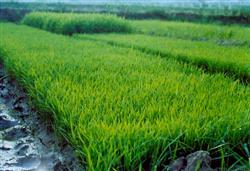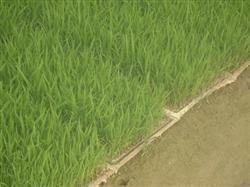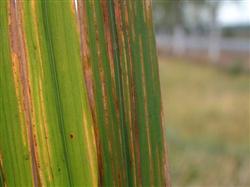Common problems and Countermeasures of Rice Seedling raising

Cultivating strong seedlings is the key to high yield of rice. Through the analysis of the common problems in raising seedlings, the corresponding countermeasures were put forward in order to provide technical reference for cultivating high-yield and strong seedlings. (1) common problems and countermeasures of mechanical transplanting and raising seedlings 1. The emergence of seeds is poor. Mechanical transplanting often appears the phenomena of poor seed emergence, irregular emergence and uneven distribution of seedlings in the seedling plate, which affects the quality of mechanical transplanting, and even can not be planted by machine in serious cases. It is mainly caused by poor seed quality, low germination rate, improper treatment of seedling plate soil and so on. The countermeasures are as follows: first, we should do a good germination test before raising seedlings, and select seeds that meet the standard to raise seedlings. In the process of seedling bed soil treatment, appropriate types of fertilizers should be selected, and the amount of fertilizer and seedling strengthening agent should also be appropriate. Before raising seedlings in dry land, a small-scale seedling raising experiment should be carried out to determine whether it can be used as nutritive soil for raising seedlings. The fertilizer for raising seedlings should be compound fertilizer, and the application amount of seedling strengthening agent should be suitable. Barnyard manure, urea and ammonium bicarbonate are forbidden to be used as base manure directly. At the same time, fertilizer and seedling strengthening agent cannot be added to cover soil after sowing. 2. "wearing a hat" seedling. In the process of mechanically transplanting seedlings, there are often many "hat" seedlings (covered soil is raised by seedlings), and some slow-growing seedlings are pulled up by sticking to the top soil, resulting in white roots hanging in mid-air; the unpulled seedlings have no cover soil, and the roots are exposed. This phenomenon is mainly caused by dry land soil seedling cover soil consolidation, over-drying, uneven thickness, too much bed water and so on. Corresponding countermeasures: suitable mulching soil should be selected for raising seedlings in dry land, with uniform cover and suitable thickness. For the seedlings in the case of "wearing a hat", you can gently tap the twigs on the bed soil, so that the soil blocks are shattered and fall down, then uncover the film, sprinkle some fine soil appropriately, cover all the roots of the seedlings, and then spray some water lightly. keep the roots moist, wash the soil stuck to the leaves at the same time, and finally restore the film. 3. Seedling blight. Rhizoctonia solanacearum is a disease that needs to be controlled when transplanting seedlings. When harmed by Rhizoctonia solanacearum, the stem base of the seedling first turns yellow to yellowish brown, when it is serious, it decays and softens, and the whole plant wilts or turns yellow to brown death. Once mechanical transplanting seedlings are damaged by rice blight, it often results in insufficient number of mechanized transplanting seedlings, and manual replanting is necessary when the leakage is serious. For the prevention and control of blight, first of all, do a good job in the preparation of bed soil and acid adjustment, and adjust the pH value to less than 6.0; secondly, the soil can be disinfected, and 70% Dixong 600-800 times solution can be sprayed on the bottom soil of seedling bed before sowing and wet cover soil after sowing, and the bottom soil and cover soil can be sprayed once respectively, which can not be repeated to avoid drug damage; during the period from 1 leaf to 2 leaves and 1 heart of seedlings, spraying leaf surface with 600 times solution of 70% Dioxong for 1-2 times. (2) Common problems and countermeasure techniques of dry seedling raising. Yellowing dead seedlings or standing dead seedlings. The main reason is that the soil does not adjust acid or improper allocation, so that the soil pH value is too high, it is easy to yellowing dead seedlings or dead seedlings. Countermeasures: first, dry raising seedlings can not be carried out when the pH value of the seedling bed is greater than 8, and when the pH value of the seedling bed is about 7.5, the soil should be adjusted with sulfur powder 2-3 months in advance, 200g per square meter, so that the pH value of the dry nursery seedling bed can reach 4.5-5.5. the second is to mix seeds with "dry nursery nanny"; third, once the wilt or dead seedlings are found, immediately use 500x dimethazone solution for control. two。 The emergence of seedlings is irregular. The lack of bottom water during dry seedling sowing directly led to irregular emergence of seedlings, and the phenomenon of large and small seedlings appeared in the later stage. Solution: it is required that the bottom water should reach a saturated state when sowing, and if the bed soil is found to be white or cracked in the seedling stage, it should be replenished in time so as not to affect seedling emergence. 3. Improper selection of herbicides. If herbicides are not applied after dry seedling sowing, weeds symbiosis after seedling emergence, which affects the robust growth of seedlings and the quality of seedlings is poor. The countermeasures are as follows: first, special herbicides must be used to control weeds after sowing, such as Xanyangjing and Xinye, etc., and the second is to use the time of refining seedlings after emergence to manually remove weeds in time to avoid the phenomenon that weeds grow faster than seedlings. (3) Common problems and countermeasures of moist seedling raising 1. Rice seeds are not soaked to speed up budding and sowing. In production, some farmers do not soak seeds to promote sprouting and sowing, that is, dry rice seeds are sown, and the temperature is relatively low after sowing, which can easily lead to rotten seeds. Solutions: first, we should publicize the benefits of soaking seeds to promote budding and sowing. Second, if it is found that farmers dry rice seeds and sow seeds, it is required that seedling ditch water should not be used. The third is to guide farmers to cover the plastic film strictly for heat preservation, and they can also cover the surface of the box with a layer of film, that is, double film. two。 Promote the bud and burn the bud. Sprouting is the yellowing and even decay of buds caused by high temperature in the process of budding. Solutions: first, we should frequently check the budding temperature, replanting in about 3 hours to cool down. Second, after the chest is broken, the temperature is controlled at 25-28 ℃. If you find that the temperature is more than 30 ℃, you should turn the pile and drench it with clean water, and continue to sprout after the temperature drops. 3. The phenomenon of rotten seeds and dead seedlings. Rotten seeds and dead seedlings occur from time to time in rice production. The countermeasures are as follows: first, to select seeds that are not moldy or moth-eaten; second, to change water frequently when soaking seeds; third, to promote germination at a suitable temperature; fourth, to uncover the film to cool down in case of high temperature after sowing and emergence; to cover the film to keep warm when the cold wave comes; fifth, to strengthen the management of fertilizer and water; to cultivate strong seedlings; sixth, to pay attention to the prevention and control of rice blast.
- Prev

How to prevent Diseases and insect pests in the stage of raising Rice seedlings
The phenomena of sitting, yellowing and lag are easy to occur in the stage of raising rice seedlings. The fields where sitting traps have occurred should be drained immediately to increase temperature and ventilation to reduce toxicity, and at the same time, quick-acting nitrogen, phosphorus and potassium fertilizers should be applied to supplement micro-fertilizers, with emphasis on zinc fertilizer, and those with symptoms of element deficiency should apply fertilizer deficiency in time, withdraw water and dry the fields or detour.
- Next

One-time fertilization technique for Rice
The distribution of rice bacterial leaf streak is referred to as rice fine leaf streak, which is one of the most important rice diseases in the world. The pathogen belongs to the genus Xanthomonas. Most of the pathogens invade from the stomata of leaves, and the disease can occur in any growth period of rice. The disease spot is a short and thin narrow spot, with stripes appearing between the veins of the leaves.
Related
- The first cup of black tea in spring, the flavor and history of tea gardens in Kenya, Africa
- The computer can not only choose potatoes, but also grow tea rice. AI will grow winter oolong tea champion.
- It is not only the inflated tea bitten by insects, but also engraved with the four seasons tea in Beipu.
- The Oriental Beauty Tea Festival in Zhuxian County takes the stage at the weekend to experience the plus-size feast of oil tea.
- & quot; Oriental Beauty Tea & Exploration of Emei in Hsinchu, the hometown of quot;
- The new variety of strawberry "Tainong 1" dessert is the first choice with mellow aroma. Crimson gorgeous
- History of Tea in Taiwan: from Wild Inner Mountain to Export Tea Garden
- Two types of Taiwan Oriental Beauty Black Tea won the British three-Star Award for Childhood Tea Xiang Zhang Jiaqi changed from pilot to champion tea maker.
- Banana species and varieties: the planting history of Taiwan Xianren banana and dwarf banana is long, is banana disease resistant?
- Coffee planting Technology: Qianjie Coffee from Seedling to harvesting

